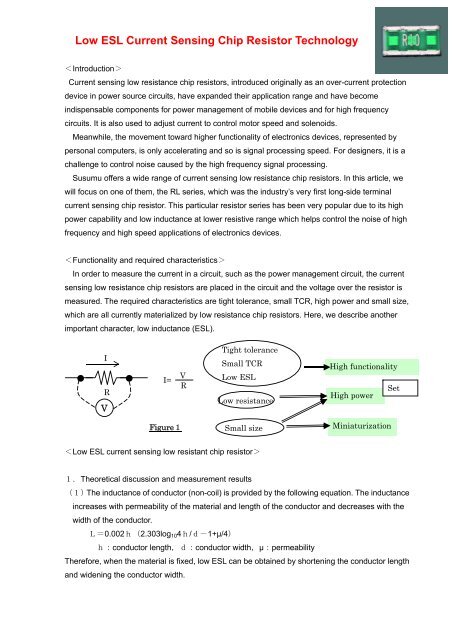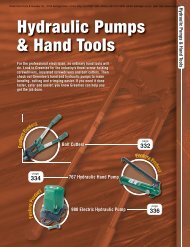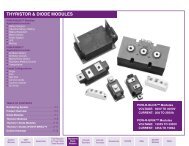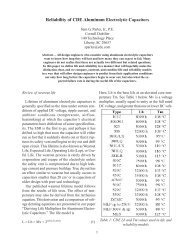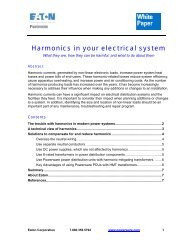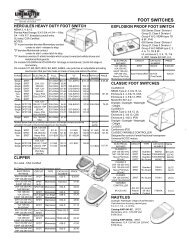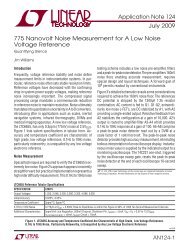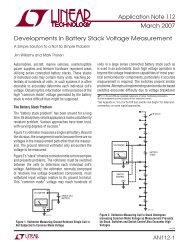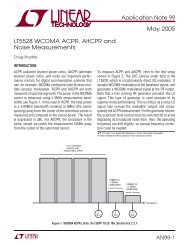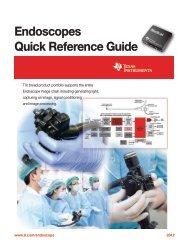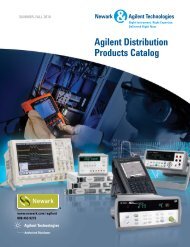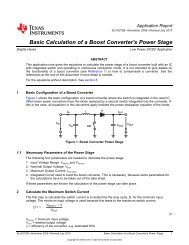Low ESL Current Sensing Chip Resistor Technology - Newark
Low ESL Current Sensing Chip Resistor Technology - Newark
Low ESL Current Sensing Chip Resistor Technology - Newark
You also want an ePaper? Increase the reach of your titles
YUMPU automatically turns print PDFs into web optimized ePapers that Google loves.
<strong>Low</strong> <strong>ESL</strong> <strong>Current</strong> <strong>Sensing</strong> <strong>Chip</strong> <strong>Resistor</strong> <strong>Technology</strong><br />
<br />
<strong>Current</strong> sensing low resistance chip resistors, introduced originally as an over-current protection<br />
device in power source circuits, have expanded their application range and have become<br />
indispensable components for power management of mobile devices and for high frequency<br />
circuits. It is also used to adjust current to control motor speed and solenoids.<br />
Meanwhile, the movement toward higher functionality of electronics devices, represented by<br />
personal computers, is only accelerating and so is signal processing speed. For designers, it is a<br />
challenge to control noise caused by the high frequency signal processing.<br />
Susumu offers a wide range of current sensing low resistance chip resistors. In this article, we<br />
will focus on one of them, the RL series, which was the industry’s very first long-side terminal<br />
current sensing chip resistor. This particular resistor series has been very popular due to its high<br />
power capability and low inductance at lower resistive range which helps control the noise of high<br />
frequency and high speed applications of electronics devices.<br />
<br />
In order to measure the current in a circuit, such as the power management circuit, the current<br />
sensing low resistance chip resistors are placed in the circuit and the voltage over the resistor is<br />
measured. The required characteristics are tight tolerance, small TCR, high power and small size,<br />
which are all currently materialized by low resistance chip resistors. Here, we describe another<br />
important character, low inductance (<strong>ESL</strong>).<br />
I<br />
● ●<br />
R<br />
V<br />
I= V<br />
R<br />
Figure1<br />
Tight tolerance<br />
Small TCR<br />
<strong>Low</strong> <strong>ESL</strong><br />
<strong>Low</strong> resistance<br />
Small size<br />
<br />
High functionality<br />
High power<br />
Miniaturization<br />
1.Theoretical discussion and measurement results<br />
(1)The inductance of conductor (non-coil) is provided by the following equation. The inductance<br />
increases with permeability of the material and length of the conductor and decreases with the<br />
width of the conductor.<br />
L=0.002h(2.303log104h/d-1+μ/4)<br />
h:conductor length,d:conductor width,μ:permeability<br />
Therefore, when the material is fixed, low <strong>ESL</strong> can be obtained by shortening the conductor length<br />
and widening the conductor width.<br />
Set
(2)Sususmu’s low <strong>ESL</strong> long-side terminal low resistance chip resistor<br />
Susumu’s long-side terminal type resistor realizes low <strong>ESL</strong> with shorter length and wider width of<br />
the resistive element by using its longer side as the terminal. The comparison of <strong>ESL</strong> among<br />
Susumu’s low resistance chip resistors is shown in Figure 2. As expected, the long-side terminal<br />
type with shorter and wider conductor demonstrates 1/3 of <strong>ESL</strong> of the regular short-side terminal<br />
type.<br />
<strong>ESL</strong> /nH<br />
6<br />
5<br />
4<br />
3<br />
2<br />
1<br />
Group 1<br />
Group 2<br />
Group 1: Electrode distance 6.4mm(part # RL-3264)<br />
Group 2: Electrode distance 3.2mm(part # RL1632゙)<br />
Group 3: Electrode distance1.6~2.0mm(part # RL3720W)<br />
Group 4: electrode distance 1.25mm(part # KRL2012)<br />
Group 1: electrode distance 6.4mm(RL-<br />
Short side<br />
electrode<br />
Long side<br />
electrode<br />
0<br />
0.1 1 10 100<br />
Frequency /MHz<br />
Figure 2 <strong>ESL</strong> comparison: long side terminal vs. short-side terminal<br />
Measurement instrumentation: 4285A PRECISION LCR METER<br />
2.Effect of low <strong>ESL</strong><br />
(1)Reduction of noise by low <strong>ESL</strong><br />
For example, laptop computers require precise power management and the DC/DC converters’<br />
switching frequency can be as high as several hundred kHz. If the <strong>ESL</strong> of the current sensing<br />
resistor is large, the transition switching pulses contain noise that affects the accuracy of the<br />
control. However, if <strong>ESL</strong> is small, such noise will become insignificant.<br />
(2)Actual measurement example<br />
Picture 1 with short side terminal<br />
Group 4<br />
Group 3<br />
Reduced noise<br />
Picture2 with long side terminal<br />
Figure 3
Picture 1 shows the shape of the waves using a short-side terminal resistor with the switching<br />
noise. Picture 2 shows the same waves when using a long-side terminal resistor, RL3720W,<br />
demonstrating a clear reduction of the switching noise. Using such low <strong>ESL</strong> current sensing<br />
resistors, the designer can avoid employing additional noise reduction circuits.<br />
3.Summary<br />
Susumu’s long-side terminal low resistance chip resistors were developed for the purpose of<br />
increasing heat dissipation realizing 1W for 3.7mm×2.0mm (RL3720W) and also for the smaller<br />
PRL1632 (1.6mm×3.2mm). Due to this high power capability, these chip resistors have been very<br />
popular. In addition, new demand has been developing because of their low <strong>ESL</strong> due to the trend<br />
in electronics for high functionality and high speed/frequency. The table below shows summary<br />
specification data of Susumu’s long-side terminal current sensing low resistance chip resistors, the<br />
RL, and the PRL series, as well as the latest low TCR KRL series.


